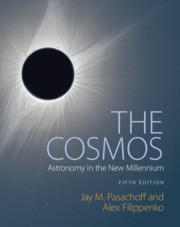130 results
Preliminary Report on the 14 December 2020 Total Solar Eclipse Observations
-
- Journal:
- Proceedings of the International Astronomical Union / Volume 15 / Issue S367 / December 2019
- Published online by Cambridge University Press:
- 23 December 2021, pp. 43-47
- Print publication:
- December 2019
-
- Article
-
- You have access
- Export citation
4. - Observing the Stars and Planets: Clockwork of the Universe
-
- Book:
- The Cosmos
- Published online:
- 08 January 2021
- Print publication:
- 11 July 2019, pp 74-105
-
- Chapter
- Export citation
17. - Quasars and Active Galaxies
-
- Book:
- The Cosmos
- Published online:
- 08 January 2021
- Print publication:
- 11 July 2019, pp 522-551
-
- Chapter
- Export citation
8. - Pluto, Comets, Asteroids, and Beyond
-
- Book:
- The Cosmos
- Published online:
- 08 January 2021
- Print publication:
- 11 July 2019, pp 224-261
-
- Chapter
- Export citation
13. - The Death of Stars: Recycling
-
- Book:
- The Cosmos
- Published online:
- 08 January 2021
- Print publication:
- 11 July 2019, pp 380-413
-
- Chapter
- Export citation
10. - Our Star: The Sun
-
- Book:
- The Cosmos
- Published online:
- 08 January 2021
- Print publication:
- 11 July 2019, pp 288-315
-
- Chapter
- Export citation
12. - How the Stars Shine: Cosmic Furnaces
-
- Book:
- The Cosmos
- Published online:
- 08 January 2021
- Print publication:
- 11 July 2019, pp 356-379
-
- Chapter
- Export citation
Brief Contents
-
- Book:
- The Cosmos
- Published online:
- 08 January 2021
- Print publication:
- 11 July 2019, pp vii-xvii
-
- Chapter
- Export citation
6. - The Terrestrial Planets: Earth, Moon, and Their Relatives
-
- Book:
- The Cosmos
- Published online:
- 08 January 2021
- Print publication:
- 11 July 2019, pp 132-187
-
- Chapter
- Export citation
5. - Gravitation and Motion: The Early History of Astronomy
-
- Book:
- The Cosmos
- Published online:
- 08 January 2021
- Print publication:
- 11 July 2019, pp 106-131
-
- Chapter
- Export citation
Appendix 1/2. - Measurement Systems/Basic Constants
-
- Book:
- The Cosmos
- Published online:
- 08 January 2021
- Print publication:
- 11 July 2019, pp 645-646
-
- Chapter
- Export citation
15. - The Milky Way: Our Home in the Universe
-
- Book:
- The Cosmos
- Published online:
- 08 January 2021
- Print publication:
- 11 July 2019, pp 446-477
-
- Chapter
- Export citation
21. - Epilogue
-
- Book:
- The Cosmos
- Published online:
- 08 January 2021
- Print publication:
- 11 July 2019, pp 644-644
-
- Chapter
- Export citation

The Cosmos
- Astronomy in the New Millennium
-
- Published online:
- 08 January 2021
- Print publication:
- 11 July 2019
-
- Textbook
- Export citation
Appendix 4. - The Brightest Stars
-
- Book:
- The Cosmos
- Published online:
- 08 January 2021
- Print publication:
- 11 July 2019, pp 649-650
-
- Chapter
- Export citation
Appendix 8. - Star Names
-
- Book:
- The Cosmos
- Published online:
- 08 January 2021
- Print publication:
- 11 July 2019, pp 658-660
-
- Chapter
- Export citation
14. - Black Holes: The End of Space and Time
-
- Book:
- The Cosmos
- Published online:
- 08 January 2021
- Print publication:
- 11 July 2019, pp 414-445
-
- Chapter
- Export citation
Appendix 3. - Planets and Dwarf Planets
-
- Book:
- The Cosmos
- Published online:
- 08 January 2021
- Print publication:
- 11 July 2019, pp 647-648
-
- Chapter
- Export citation
16. - A Universe of Galaxies
-
- Book:
- The Cosmos
- Published online:
- 08 January 2021
- Print publication:
- 11 July 2019, pp 478-521
-
- Chapter
- Export citation
11. - Stars: Distant Suns
-
- Book:
- The Cosmos
- Published online:
- 08 January 2021
- Print publication:
- 11 July 2019, pp 316-355
-
- Chapter
- Export citation

